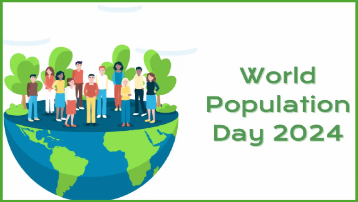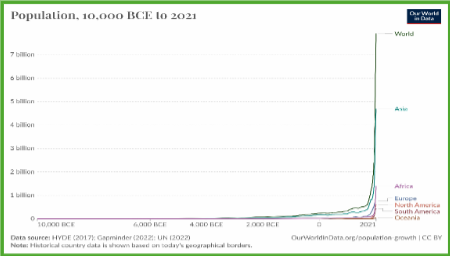World Population Day, July 11, 2024

Background:
Population growth is one of the most important topics.
Fast Growth is recent phenomenon: For most of human history, the global population was a
tiny fraction of what it is today. Over the last few centuries, the human population has gone
through an extraordinary change. In 1804, which actually means millions and millions of years
after being in existence, for the first time, there were one billion people. By 2022, there are more
than 8 billion of us. In 1927 we were two billion, 1960, three billion, 1974, four billion, 1987 five
billion, 1998 six billion, 2010, seven billion, 2022, we are eight billion and projection is that by
2037 we will be nine billion and by 2058 we will be 10 billion.
This dramatic growth has been driven largely by increasing numbers of people surviving to
reproductive age and has been accompanied by major changes in fertility rates, increasing
urbanization and accelerating migration. These trends will have far-reaching implications for
generations to come.
But after a period of very fast population growth, demographers expect the world population to
peak by the end of this century. This is due to higher deaths at senior age and decreased birth
rates such that birthrate starts matching death rates.

The steep ascent over the past two centuries has created growing pains for families,
communities, countries, and the planet. Consumption levels vary by individual and by world
region, but everyone has infrastructure needs and contributes to environmental degradation to
some degree. The more people who need food, water, shelter, health care, education, and
employment, the more our agricultural systems, human institutions, and public infrastructure will
need to grow and the more the environment and other species feel the strain.
Globally, projected world population on Jan. 1, 2024, is 8,019,876,189, an increase of
75,162,541 (0.95%) from New Year’s Day 2023. During January 2024, 4.3 births and 2.0
deaths occurred worldwide every second.
United States Population: The current population of the United States of
America is 341,844,361 as of Sunday, July 7, 2024, based on World meter elaboration of the
latest United Nations data.
The United States 2023 population is estimated at 339,996,563 people at midyear.
• The United States population is equivalent to 4.23% of the total world population.
• The U.S.A. ranks number 3 in the list of countries (and dependencies) by population.
• The population density in the United States is 37 per Km 2 (96 people per mi 2 ).
• The total land area is 9,147,420 Km2 (3,531,837 sq. miles)
• 82.9 % of the population is urban (281,984,165 people in 2023)
Human activities have led to the introduction of countless harmful contaminants into the
environment. Air, water, and soil pollution damage human and ecosystem health and are
amplified by population growth and rising per capita consumption, as well as unethical corporate
behavior.
As with other environmental issues, disadvantaged and marginalized communities are
disproportionately exposed to harmful pollutants, both here in the United States and around the world.
Needless to say, developing world bears all the consequences, while on average, people
living in the United States produce almost 28 times more consumption-based
CO 2 emissions than people in Nigeria, one of the fastest-growing countries in the world.
World Population Day was suggested by Dr. K.C.Zachariah, Sr Demographer who worked at
World Bank when population reached five. While press interest and general awareness in the
global population surges at the increments of whole billions of people, the world population
increases by 100 million approximately every 14 months! Thus, the day originates from the day
when the world population reached 5 billion.
World Population Day seeks to focus attention on the urgency and importance of population
issues. It was established by the then-Governing Council of the United Nations Development
Program in 1989, an outgrowth of the interest generated by the Day of Five Billion, which was
observed on 11 July 1987.
By resolution 45/216 of December 1990, the United Nations General Assembly decided to
continue observing World Population Day to enhance awareness of population issues, including
their relations to the environment and development.
The Day was first marked on 11 July 1990 in more than 90 countries. Since then, a number of
organizations and institutions commemorate World Population Day, in partnership with
governments and civil society.
The theme for World Population Day changes annually. Some previous themes include:
• 2023: “Unleashing the power of gender equality: Uplifting the voices of women and girls
to unlock our world’s infinite possibilities”
• 2022: “A world of 8 billion: towards a resilient future for all”
• 2021: “Impact of Covid-19 pandemic on fertility”

The World Population Day 2024: To Leave No One Behind, Count Everyone.
Over the past three decades, societies around the world have made remarkable progress in
improving population data gathering, analysis, and use. New population figures, disaggregated
by age, ethnicity, gender, and other factors, now reflect the diversity of our societies more
accurately.
These advancements have significantly enhanced the delivery of health care globally, leading to
substantial improvements in sexual and reproductive health and the ability to exercise rights and
choices. Increasingly, new technologies are enabling more detailed and timely measurement of
people’s experiences than ever before.
However, the most marginalized communities remain underrepresented in data, profoundly
affecting their lives and well-being.
World Population Day 2024 is a moment to ask who is still going uncounted and why – and what
this costs individual, societies, and our global efforts to leave no one behind. It is also a moment
for all of us to commit to doing more to ensure that our data systems capture the full range of
human diversity so that everyone is seen, can exercise their human rights and can reach their
full potential.
To realize the rights and choices of those on the margins of our societies, we must count them –
because everyone counts. Our rich human tapestry is only as strong as its weakest thread.
When data and other systems work for those on the margins, they work for everyone. This is
how we accelerate progress for all.
The theme for World Population Day 2024 is “To Leave No One Behind, Count Everyone”.
The theme focuses on the following key points:
- Importance of data collection: Investing in data collection is crucial to understanding population issues and driving progress. To be able to see the disparity and problems, we must first have them in our mind. Eyes cannot see that mind does not know.
- Counting marginalized communities: Marginalized communities are groups of people who face discrimination or exclusion based on their race, ethnicity, gender, disability, religion, or socioeconomic status. When marginalized communities are not included in national data collection, it can lead to inaccurate demographic estimates, underrepresentation in government, and inefficient use of resources. The theme emphasizes counting marginalized communities and ensuring that everyone is included in data collection.
- Ensuring human rights: The obligation to protect requires States to protect individuals and groups against human rights abuses. The obligation to fulfill means that States must take positive action to facilitate the enjoyment of basic human rights. The theme highlights the importance of ensuring human rights, especially for marginalized communities.
- Empowering individuals: Empowering people means engaging them and cooperating with their needs. You can greatly help people by focusing on their needs and abilities. When you have access to every individual’s knowledge and skills, and you also trust them to do their jobs without your micromanaging, the community becomes independent and more efficient. The theme aims to empower individuals, especially those on the margins of society, to reach their full potential.
Asian Pacific Community in Action’s mission resonates strongly with importance of data
collection, particularly of marginalized communities, ensuring human rights, and empowering
individuals. At the community level, we need to be aware of the population problems and
advocate the resource allocation and priorities that it demands from the civil society,
government and international agencies.





